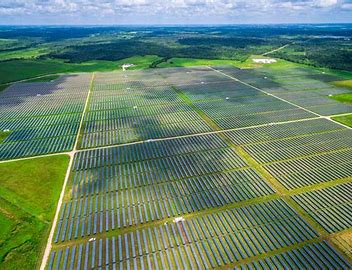Solar Farm
The latest cash crop to arrive on farm fields: solar panels. That is right solar farms are sprouting up across America in all shapes and sizes, from small ones that light up local communities to gigantic, utility-scale solar farms that power thousands of homes. In the last decade alone, solar has experienced an average annual growth rate of 49%. Much of this growth is due to the number of solar farms popping up around the U.S. Today, there is enough solar power on the grid to power 15.7 million homes. Now, that is a lot of electricity from sunshine to go around. Let us talk more about solar farms, the several types of farms out there and the specifics such as the cost, the power output and more.
What is a solar farm? A solar farm is an ample collection of photovoltaic (PV) solar panels that absorb energy from the sun, convert it into electricity and send that electricity to the power grid for distribution and consumption by customers like you. Solar farms are usually mounted to the ground instead of rooftops and come in all shapes and sizes.
Of the tens of thousands of solar panel farms in the U.S., they can be grouped into two types, both based on size. Utility-scale and Community solar are both types of solar farms.
Utility-Scale Solar Power. Primarily, the phrase “utility-scale” can be a bit misleading. Technically, all solar energy projects whether it is a few rooftop panels or a whole acre are “on the grid” providing the local utility company with solar-powered electricity. The only time a solar energy project is not truly utility-scale is when it is completely disconnected from the grid and not connected through a power line. This is never the case.
But for our purposes and most discussions of this nature, utility-scale solar farms refer to those massive areas of land where solar panels stretch beyond the horizon. Such installations consist of hundreds of thousands of solar panels that absorb energy from the sun, generate an electric current and distribute that power on high-voltage power lines. The electricity travels along those power lines to the electricity grid, eventually making its way to your home.
These facilities, typically operate on power purchase agreements, wherein large corporations or the utility agree to purchase a specific amount of electricity from the generator (owner). In the case of corporations, this is always at a substantial discount to the retail electricity rate they would otherwise pay!
That is just one side of the solar farm coin! The other consists of the thousands of smaller scales farms the industry refers to as community solar.
Community solar farms are small-scale solar facilities that generate around 5 MW of electricity for a local community of homes and businesses. The power is shared among everyone who participates in the program. Depending on the number of residents and the amount of production, the residents could get a reduction in their electricity bill for investing in this solar project.
Here is how it works:
The solar panels are installed in a large, undeveloped area of the neighborhood that receives maximum exposure to sunlight. The solar energy gets fed into the larger electricity grid for the region. People who joined the solar program will see their energy bill adjusted for energy generated in relation to the size of their home.
This is possible with technology called “virtual net metering.” Your retail energy company will credit your bill for electricity your community solar farm generates in proportion to your home’s
energy load. Community solar also differs from utility-scale solar because it is considered distributed energy or distributed generation resource (DER). The electricity produced by the community solar farm is used to power the homes within a close range. Thus, they are less likely to lose power if the grid goes down.
In contrast, electricity made by utility-scale solar farms can travel for miles and miles until it reaches its destination, be it your home or business.
Landowners are the winner in both community solar and utility solar farms. Lucrative land leases for 20, 30, or even 40 years can be negotiated with the solar farm owner providing passive income from the sun for decades!

Contact Us:
If you are a landowner looking to receive passive income, or a corporation looking to offtake solar energy from a solar farm contact us today: info@beachcitiessolarconsulting.com

